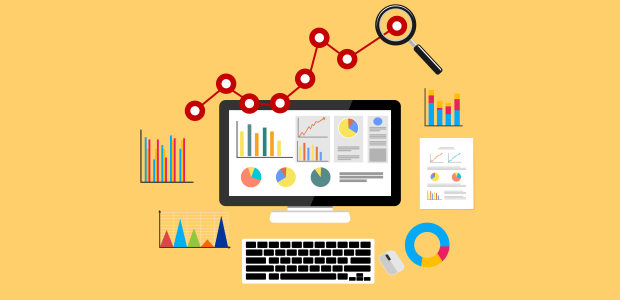In order to move further towards value based care it is necessary for organizations to make more use of data analytics. In order to improve outcomes for patients at a lower cost with higher patient satisfaction, it is necessary to collect data and analyze it. There are many ways to do this and I will point out a few, including some that I use.
Healthcare is awash in data. There is data from billing, including diagnostic and procedure codes. There is claims based data from payers. There is much more detailed data in EHR’s, such as test results. This data is clinical data. Financial data is also important. Much of this data can be found in financial software such as QuickBooks and patient management software.
To make effective use of this data it is necessary to organize it, graph it, and investigate for significant changes. Each of these requires the use of statistics, either at an elementary level for spotting trends or at an advanced level to see if there are real and significant changes that indicate that the provider is moving towards providing better care at a lower cost. The examination and analysis of data gathered from patients and grouped by patient characteristics is termed population level health management.
One approach to using analytics to improve patient health is examine and track key indicators for patients with chronic diseases, usually the patients that incur the greatest cost in a practice. For instance, a practice can collect and analyze the A1c levels of all patients diagnosed with diabetes. This data can be collected each month and a mean and standard deviation determined. A month by month graph using an Excel spreadsheet will help visually indicate any trends that are occurring. If over a period of several months there is an upward trend, action can be taken to disrupt the trend. This could be making use of a nurse coordinator to help patients better manage their diabetes. One could use Control Charts from engineering statistics to better analyze whether trends are real or due to random fluctuations which are normal in any data collection over a time period. One could also use statistical t-tests to determine whether the changes are truly significant or not.
It can be very useful to graph data collected such as A1c levels, plotting the means over time as indicated above, and present them in a Dashboard with brief descriptions and analysis. These dashboards can be shared in a practice in order to drive improvement. This can be very effective in making improvements with a care team. I recently listened to a NPR podcast from ‘The Hidden Brain’ that described how a hospital in Pittsburgh improved its handwashing by care givers before entering patient rooms. The rate hovered around 10% for a long time in spite of repeated education of care givers. Then, the hospital started displaying monthly statistics of handwashing in a dashboard that all could access and see. Management focused care givers attention on the dashboards. Handwashing rates quickly improved to 90% and stayed there. The visuals made a significant impact on awareness of handwashing by providers.
Analytics can also be used to make improvements in patient satisfaction scores. The Medical Group Management Association (MGMA) provides a very good patient satisfaction survey for its members. I have adapted it to different providers depending upon their demands. The survey covers 36 basic questions and ends with “Would you recommend the provider to other?”, a very good ending question. I also add demographic questions. Providers can use the survey with patients and track performance in five areas-making the appointment, quality of front office staff and billing, ease of communication, visit with clinicians, and state of facilities. The goal is to have as a high as possible composite score for each of these areas. With advanced analysis more can be found out to improve satisfaction. It is possible to identify which of the questions have the most impact on the last question. It has been found that patients who are most likely to refer a practice to friends and family are usually the most satisfied. Thus, finding out which of the many questions have the most impact on this can help identify which areas need improvement. Analysis of which questions have the greatest impact should be carried out on a regular basis as the ones that have the greatest impact can change over time.
Of course, a dashboard should be created to report to staff the results of the surveys each month or so. This will help incentivize the staff to perform even better. If management likes it may break down the results by staffing area or by provider to help identify where individuals may improve. Individual coaching can then be used to help staff make improvements. Never should the dashboards be used to berate staff though. Whether individual dashboards are shared with other staff depends upon how well the staff functions as a team, how mutually supportive they are.
The MGMA collects a lot of data from its members through surveys. It then provides data for benchmarking to its members, some for free and some for costs. Providers who participate in their surveys can often get the results for free. In a recent article in its monthly publication Connection it provided a dashboard of data on the most profitable independent practices. It found, contrary to common sense, that those organizations with the highest median costs per FTE physician also were the most profitable. Some of the data in the dashboard follows:
· Median total medical revenue per FTE physician = $1,169,542
· Median total operating cost per FTE physician = $630,680
· Median total physician compensation and benefit = $462,722
· Median total support staff per FTE physician = 5.12
The article, Designing the practice of the future, found in the March 2017 issue of the magazine, also provided the benchmark data for all multispecialty practices. This data along with other data in the article and the article analysis can help providers develop long term strategies to improve the profitability of their practice.
As you can see there are many ways to use data and data analysis to improve the outcomes at your care site. It is important to identify which data to collect and analyze to make the most significant impact. As I said care providers are awash in data and trying to analyze it all would be a waste of time and energy. Those just beginning to use advanced analytics should start off with a few data projects and expand as time goes on. Intelligently using data and analysis can make a significant impact on the care that you provide and on your bottom line.





















